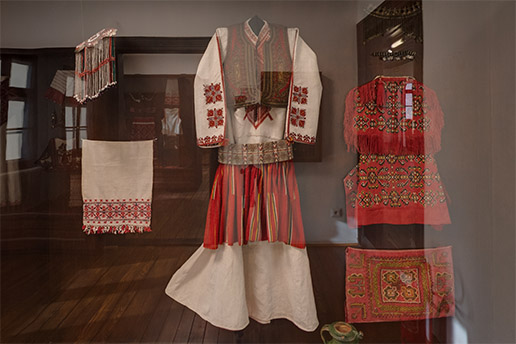Ethnographic Museum in Belgrade
www.etnografskimuzej.rs

Manak’s House is a museum governed by the Ethnographic Museum in Belgrade which houses and exhibits the legacy collection bequeathed by Hristifor Crnilović, painter and researcher of folk culture. This monument of culture is located in the Belgrade neighborhood of Savamala, in Gavrila Principa 5 street, and is one of the rare preserved examples of old Balkan architecture. Originally an inn, after four years of reconstruction between 1964 and 1968 it was turned into a museum.
Hristifor Crnilović, born in Vlasotince on February 8, 1886, studied art in Munich after being enrolled in the art school of Rista Vukanović in Belgrade. Upon completing his studies in 1911, he returned to Serbia where he was appointed as a drawing instructor at a secondary school in Negotin. He participated in the Balkan wars, as well as the First world war. Afterwards, he received a position in Skoplje, and during 1920-1921 he studied at the Académie de la Grande Chaumière in Paris. Over time, Crnilović increasingly dedicated himself to research and collecting artifacts of traditional culture. In this work, he was assisted by his younger sister Zora Crnilović, literature teacher. It was his wish that the entire collection, along with illustrative and handwritten materials, as well as his library, be donated to the City of Belgrade. The city has, for the purpose of its safekeeping, provided the space of the newly-renovated Manak’s House.
The legacy collection of Hristifor Crnilović consists of 2600 artifacts, over 1600 negative photo plates and negative films, an accessory library containing over 700 books and journals, as well as around 22,000 handwritten pages in 236 notebooks with various notes, drawings, photos, quotations etc.
The permanent exhibition, Traditional Folk Dress and Jewelry of the Central Balkan Area in the 19th Century and the First Decades of the 20th Century was opened on November 17, 1968. The setting up of the exhibition, as well as the professional, museological and scholarly processing of the materials from the collection were entrusted to the Ethnographic Museum in Belgrade. The exhibition presents the basic elements of Crnilović’s ethnographic research in the field, mainly in southern Serbia, Kosovo and Metohija, as well as Macedonia, between the two world wars.
The house itself was built around 1830 on the old road connecting Varoš kapija with the neighborhood of Savamala. It got its name after Manak Mihailović, who was mentioned as its owner in the List of inns, pubs and gardens in Belgrade from 1860. According to available evidence, Manak Mihailović was an Aromanian immigrant from Macedonia, and the name of a certain Manojlo Manak – a Greek from Kastoria – is also mentioned in the capacity of resident. It is not known whether they are two different persons or the same one.
Architecturally speaking, the house was made under the influence of Oriental culture, and the construction consists of timber framing filled with adobe bricks, projecting oriels (doksat) and porches, roofs covered with curved terracotta tiles, and overhanging eaves. Given the sloping of the terrain, the house has three levels: basement, ground floor, and first floor. It was renovated in 2016.
Project supported by: